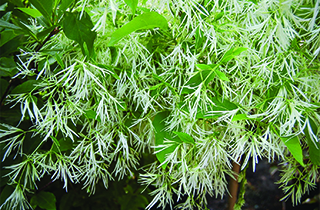White fringetree does double duty

The best advice I can give someone who wants to know how to have a low-maintenance garden is threefold: Always select plants with a proven track record; don’t overplant a space; and don’t choose plants that are too big for the space you have.
I AM FREQUENTLY ASKED TO RECOMMEND SMALL TREES that are low-maintenance, but the request really should be for a large shrub that looks like a tree. Even small trees can grow 20 to 25 feet tall and are often equally wide, so a large shrub that looks like a tree or can be trained into a tree shape is often a more appropriate choice.
WHITE FRINGETREE IS AN EXCELLENT LARGE SHRUB with an open habit or tree-like shape, and grows only 12 to 15 feet tall in most urban environments. Chionanthus virginicus has beautiful, fleecy white, fragrant flowers that emerge in May just as the leaves are unfurling.
THE SIMPLE LEAVES ARE MEDIUM GREEN, SLIGHTLY SHINY, and provide a beautiful backdrop for the flowers. The large leaves provide an interesting, rich texture to the summer garden after flowering is complete. The fall color is yellow.
IT IS BEST PLANTED IN FULL SUN TO PART SHADE and prefers good soil. Plant it singly, in a row, or in a group, and you will be rewarded with its beauty from spring to fall. It is pretty with perennial flowers or groundcover planted underneath in a natural garden setting. With adequate growing room, it generally doesn’t require pruning, making it an excellent low-maintenance option for many gardens.
SHELLY NOLD is a horticulturist and owner of The Plant Kingdom. Send stories and ideas to her at The Plant Kingdom, 4101 Westport Road, Louisville, KY 40207.
ASK THE GARDENER
By Angie McManus
Q I have little holes in all my hostas this year. Can you tell me what type of bug does this and what the remedy might be?
A When it comes to hostas, the most common pest problem is the slug. These two seem to go hand in hand and the damage of small, round holes is exactly what you have described. Slugs are nocturnal feeders, so you will not find them on your perennials during the day. Control options include diatomaceous earth and Sluggo, which are both organic products you should be able to find at your local garden center. As with any product, be certain to follow recommended application rates.
Home remedies include a shallow bowl of beer, and melons also work great. Leave the bowl of beer out at night while the slugs are feeding and in the morning you will find the culprits and be able to dispose of them. As for the melon, any kind will work; of course, enjoy it first and then place the hollowed-out part face-down in the garden. Again, do this at night and the next morning you will have a melon full of slugs. Toss them in the trash.
If you start a control program early next spring, you should be able to deter these slimy pests from feeding on your herbaceous perennials and the foliage will not be full of holes.
Have a Gardening Question?
Ask The Gardener

